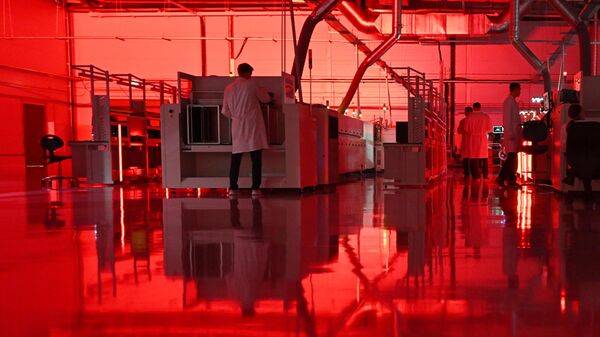The analysis of these samples, published on Thursday in the journal Nature, marks the first-ever paleomagnetic data obtained from the moon's far side, and offers critical insights into the intermediate evolutionary stages of the lunar dynamo, the geophysical mechanism that generated the moon's magnetic field in the past, according to Guangming Daily.
On June 25, 2024, the Chang'e-6 lunar probe returned to Earth with 1,935.3 grams of lunar samples collected from the previously unexplored far side of the moon.
Cai Shuhui from the Institute of Geology and Geophysics (IGG) under the Chinese Academy of Sciences, also first author of the paper, said that the Earth has a "magnetic field generator"—the movement of the conductive fluid in the Earth's liquid outer core acts like a "generator," which generates a magnetic field enveloping the Earth like a protective shield.
This magnetic field shields the planet from cosmic rays and protects essential elements for habitability, such as the atmosphere and water, creating an environment suitable for the proliferation of life.
The Moon once had a similar "magnetic field generator," which ceased functioning long ago. Studies of the ancient magnetic field strength based on samples returned by the US Apollo mission indicate that the Moon had a relatively active "generator" producing a magnetic field between 4.2 billion and 3.5 billion years ago. This magnetic field decreased by an order of magnitude around 3.1 billion years ago, and again declined between 1.5 billion and 1 billion years ago, ultimately ceasing to function completely at some point after 1 billion years ago.
The Chang'e 6 mission has achieved the first-ever sample collection from the far side of the Moon, with the primary eruption age of the basalt being 2.8 billion years. This provides an unprecedented opportunity to understand the temporal and spatial evolution of the Moon's "magnetic field generator."
On June 25, 2024, the Chang'e-6 lunar probe returned to Earth with 1,935.3 grams of lunar samples collected from the previously unexplored far side of the moon.
Cai Shuhui from the Institute of Geology and Geophysics (IGG) under the Chinese Academy of Sciences, also first author of the paper, said that the Earth has a "magnetic field generator"—the movement of the conductive fluid in the Earth's liquid outer core acts like a "generator," which generates a magnetic field enveloping the Earth like a protective shield.
This magnetic field shields the planet from cosmic rays and protects essential elements for habitability, such as the atmosphere and water, creating an environment suitable for the proliferation of life.
The Moon once had a similar "magnetic field generator," which ceased functioning long ago. Studies of the ancient magnetic field strength based on samples returned by the US Apollo mission indicate that the Moon had a relatively active "generator" producing a magnetic field between 4.2 billion and 3.5 billion years ago. This magnetic field decreased by an order of magnitude around 3.1 billion years ago, and again declined between 1.5 billion and 1 billion years ago, ultimately ceasing to function completely at some point after 1 billion years ago.
The Chang'e 6 mission has achieved the first-ever sample collection from the far side of the Moon, with the primary eruption age of the basalt being 2.8 billion years. This provides an unprecedented opportunity to understand the temporal and spatial evolution of the Moon's "magnetic field generator."
Researchers from the IGG studied the sample and discovered the ancient magnetic field strength of the sample found to be higher than previously thought. Cai said this suggests that after a sharp decline in the lunar magnetic field 3.1 billion years ago, there may have been a rebound or reactivation around 2.8 billion years ago.
IGG's analysis indicates that this could be due to a change in the main energy source of the "generator" or a reinforcement of the initial driving mechanism.
IGG's study is not only the first information about the ancient magnetic field on the Moon obtained by humans, but also provides key information to understanding the evolution of the Moon's magnetic field, according to Guangming Daily.
IGG's analysis indicates that this could be due to a change in the main energy source of the "generator" or a reinforcement of the initial driving mechanism.
IGG's study is not only the first information about the ancient magnetic field on the Moon obtained by humans, but also provides key information to understanding the evolution of the Moon's magnetic field, according to Guangming Daily.
This article originally appeared on the Global Times website.

 3 months ago
30
3 months ago
30







 We deliver critical software at unparalleled value and speed to help your business thrive
We deliver critical software at unparalleled value and speed to help your business thrive






 English (US) ·
English (US) ·